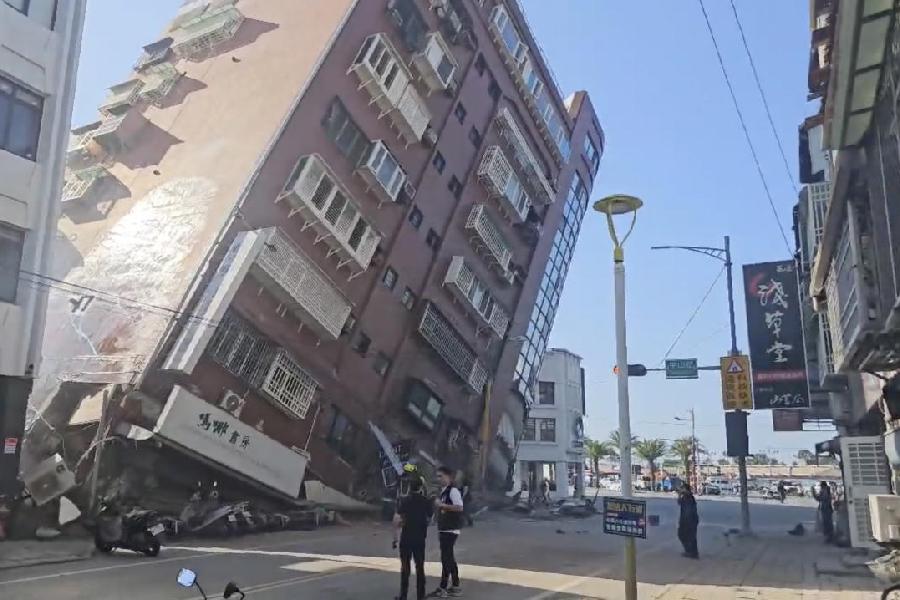The first quake was alarming enough — a rumble more powerful than anything felt in Taiwan for a quarter-century, lasting for more than a minute on Wednesday morning, knocking belongings and even whole buildings askew. It was so strong it set off tsunami warnings in Japan, China and the Philippines.
But then, even in a fault-riddled place with long and hard experiences with earthquakes, the jolt of aftershock after aftershock was startling, continuing every few minutes throughout the day.
The magnitude-7.4 quake killed nine and injured at least 1,011 others, stretching an expert quake response system that has served as a model in other places. In Hualien County, close to the epicentre, 71 people were trapped in two mining areas as of Wednesday night and dozens of others were stranded, according to officials. Forty flights were cancelled or delayed. Around 14,000 households were without water, and 1,000 households were without power.
By late Wednesday evening, 201 aftershocks had been reported, many over magnitude 5. With rain expected in the coming days, authorities warned of possible landslides.
Tsai Kuang-Hui, a retired teacher in Hualien, on the island’s east coast, near the epicentre, said that residents were choosing to remain outside. “I’m trying to fix a broken water pipe. There’s a lot of water and gas pipes that have been broken,” he said by phone.
Many residents had been at home, getting ready for work and school, when the quake struck. Others were driving on highways or had already set off on early hikes in Taiwan’s national parks ahead of a four-day holiday. After the main quake stopped, people across the island fled onto the streets to assess damaged buildings and quickly texted friends and family members reassurances and pictures of broken belongings.
But almost immediately, people felt the stomach-jolting lurch of an aftershock. Taiwan is earthquake-prone, and minor tremors are common, but these continued every few minutes throughout the day. By 3p.m., there had been 101 subsequent shocks, with at least one tremor of magnitude 6.5 and many over magnitude 5.
Officials said more aftershocks were likely in the next four days and warned residents to avoid visiting the tombs of ancestors, especially in the mountains, this weekend during the holiday, known as Ching Ming, meant to honour them. The forecast called for rain, which could make travel conditions on damaged roads more treacherous.
Although the earthquake will reverberate for a long time because it was so large, over 100 aftershocks was not unheard-of for a quake of this magnitude, said Yi-Ying Wen, an earthquake expert at National Chung Cheng University in Taiwan. “We should expect that the size of the aftershocks will slowly get smaller and smaller over the next two weeks.”
The heaviest damage was in Hualien County.
In the city of Hualien, the county seat, rescuers were focused on a brick building with glass windows called the Uranus Building, which had partially collapsed and was leaning heavily to one side. Residents emerged through windows and climbed down ladders, assisted by rescuers.
The fire department said one person in the building had died, while around two dozen others had been evacuated. Search efforts continued, but it was not immediately clear how many people were stuck in the building.
Peggy Jiang, who manages The Good Kid, a children’s bookstore down the street from the partially collapsed Uranus Building, said it was a good thing the store had yet to open when the quake struck. “Most people in Hualien are used to earthquakes,” she said. “But this one was particularly scary, many people ran into the street immediately afterwards.”
Rescuers had also freed dozens of people trapped elsewhere in the county. Three hikers were killed by falling rocks on a trail in Taroko National Park, a popular site famed for a gorge that cuts through mountains that rise steeply from the coast.
The county government opened evacuation areas where people could take shelter, such as high school gymnasiums and athletic fields, as aftershocks continued to roll through the area.
Derik du Plessis, a 44-year-old South African who has lived in Hualien for 17 years, described chaos and panic on the streets after the earthquake as people rushed to pick up their children and check on their houses.
Roads were blocked off, he said, and walls had toppled onto cars. “Right now people seem to have calmed down, but a lot of people are sitting on the road,” he said. “They don’t want to go into the buildings because there are still a lot of tremors.”
Lin Jung, 36, who manages a shop selling sneakers in Hualien, said he had been at home getting ready to take his 16-month-old baby to a medical appointment when the earthquake struck. At first, it felt like a series of small shocks, he said, then “suddenly it turned to an intense earthquake shaking up and down”. The glass cover of a ceiling lamp fell and shattered. “All I could do was protect my baby,” he said.
The quake also jolted the island’s west coast, toppling one building in Changhua County entirely. Many rail services were halted as the authorities inspected tracks for damage.
The earthquake struck during the morning commute, shortly before 8am, at a depth of 22 miles, according to the US Geological Survey.
New York Times News Service










